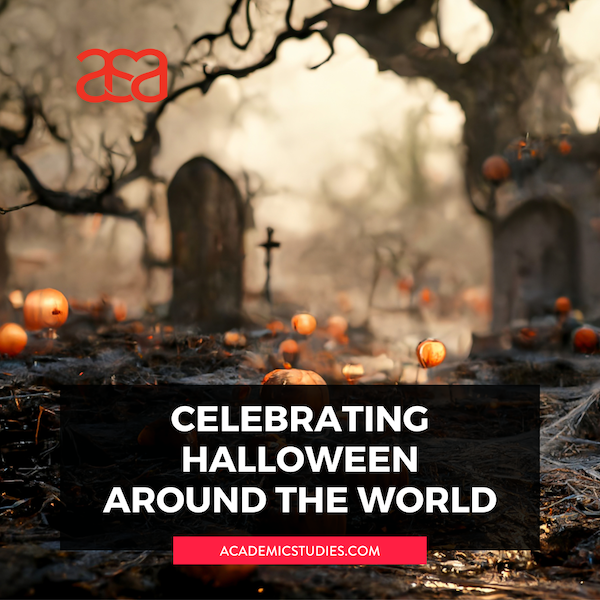Celebrating Halloween Around the World
From our earliest childhood days, most of us who grew up in America associate Halloween with traditions like visiting pumpkin patches and carving jack o’lanterns, maybe roasting the seeds, bobbing for apples, telling ghost stories, lighting candles, making Kleenex ghosts, visiting haunted houses, hanging up cotton spider webs and little black bats, drinking apple cider, having bonfires, watching horror films, dressing up in costume and, of course, trick-or-treating. As we grow up, we might adopt a more adult perspective on spooky fun, but the idea remains the same.
But what does it mean to spend Halloween in another country when you’re studying abroad? Well, it depends on where you are! Hold on to your broomsticks; here we go on a whirlwind tour through the 10 ASA countries….
ARGENTINA. If you’re a big fan of Halloween festivities, you may find Noche de Brujas in Argentina a little bit anticlimactic. Decorating homes and trick-or-treating haven’t been adopted here. Yet. However, more and more US influence appears every year, as it seems to in many countries around the world, so the extent to which the day is celebrated here may change in the future. You will find some decent costume shops in Buenos Aires now. There are also Halloween parties in the bigger clubs, especially those that attract a lot of ex-pats (though not all of them involve dressing up, so check first!). Alternatively, it could be a good day to take a wander through the historic Recoleta Cemetery.
CHILE. Like Argentina, Chile has slowly adopted some Halloween festivities, especially in bigger cities like Santiago where there are parties and children do dress in costumes and go trick-or-treating (“dulce o truco”) and some houses do put decorations up. Though it’s nowhere near as widespread a celebration as it is back home, like in Argentina, you’ll find clubs throwing parties and other festive events to enjoy.
ENGLAND. In recent years, England has adopted more of the American-style Halloween traditions. There are pumpkin patches to visit, most supermarkets sell pumpkins for carving, kids dress up in costumes, there are some trick-or-treaters out in the streets (though more low-key than in the US), and spooky storytelling events. Depending on where you are, a handful of houses on every street will likely have jack-o’lanterns outside and there will be a few with house decorations. You’ll find Halloween candy on the store shelves alongside some goodies like Cadbury Pumpkin Patch Cakes. Parties and events are easy to come across in big cities. It’s also a great time for a visit to the London Dungeon, Clink Museum, or Tower of London to soak in some of the country’s gory history.
FRANCE. From the Halloween Nights festival that’s held at Disneyland Paris to new haunted houses popping up each year and the Paris Zoo’s spotlight on strange and scary animals, the French are getting into the Halloween spirit US-style more and more each year. The Pachamama club throws a Vampire Ball and there are some Halloween-themed escape rooms to try. Even in smaller Aix-en-Provence where ASA students are based, there are ghost tours, spooky costume parties, haunted houses, and Halloween-themed cooking classes. In France, and other parts of Europe there was an old belief that all of the world’s dead would rise up on All Hallows’ Eve to have a big crazy party called the danse macabre and villagers would gather for a candlelit vigil while children dressed up to dance.
GREECE. Greeks don’t typically celebrate Halloween because of its pagan origins, but because of the expat community, it is possible to find some parties and events to attend. In Athens, you may find more nods to the holiday, but this is less likely on smaller Paros Island which is inhabited mostly by locals once the summer tourist season finishes.
IRELAND. Ireland is the place to be for Halloween celebrations and is frequently included in lists on the topic. This is partly because it is the site of the holiday’s origins. It’s largely agreed that Halloween began about 2,000 years ago, initiated by the Celtic people in Europe (in Ireland as well as other European countries) as a celebration of the end of the harvest and the start of a new year. They held a festival called Samhain (“sow-win”) with animal sacrifices, where participants would wear animal heads and skins as costumes. Dublin still hosts an annual Samhain parade. Bonfires, which attract bats, are lit to ward off evil spirits (which is how they came to be a symbol of Halloween), children dress in costumes for trick-or-treating, and there are parties with games like “snap-apple” (where you try to bite a hanging apple), treasure hunts, and card games with treats to find. There’s a traditional fruitcake called barnbrack eaten on Halloween. It has a trinket baked inside that supposedly predicts the future of the person who eats that slice. The jack o’lantern tradition also comes from Ireland, but instead of pumpkins which are popular now, it was originally faces carved into beets, potatoes and turnips. There are, of course, parties galore. All in all, if you’re Halloween obsessed, this is a great place to study abroad during Fall semester.
ITALY. Italians are slowly integrating some Halloween traditions into their lives. Some shops sell carving kits now and it’s possible to find pumpkin patches, costumes (with a definite focus on the spooky, gruesome and gory), parties, and a few decorated houses. While kids don’t really do trick-or-treating house to house, some businesses like markets, museums, or theme parks embrace the “dolcetto o scherzetto” fun by hosting costume events for kids and dishing out treats.
NETHERLANDS. Trick-or-treating has snuck into the Netherlands, but it’s more likely to be individual streets participating with routes announced in advance than a free-for-all house-to-house extravaganza. And instead of “trick-or-treat”, there’s a more gruesome request: “Je snoep or je leven” which translates to: “Your candy or your life”. Yikes! But all in good fun, of course. A large international student community in Maastricht has introduced traditions to the host city, so now you’ll find costume shops, lots of parties and other Halloween events, haunted houses and horror films.
SCOTLAND. As in Ireland, Scotland was home to the community that celebrated the original Samhain festival considered to be the origins of Halloween. The celebrations are still going strong. There are some ongoing traditions like neep lanterns (carved scary faces in turnips instead of pumpkins, though pumpkins are now just as common), bobbing for apples (or “apple dookin’”), eating messy treacle-covered scones dangling from a string while your hands are tied behind your back, burning nuts (said to predict the outcome of your relationship depending on whether they crackle and hiss or burn quietly) and “guising” (trick or treating, but kids actually perform tricks to earn their treats). If you’re studying abroad in Aberdeen, you’ll have parties, a “Dark Side” walking tour, murder mystery dinner, ghost hunts, horror con, a zombie outbreak escape room and plenty more!
SPAIN. Halloween, or El Dia de las Brujas is celebrated slightly differently depending on where in Spain you go, but big cities will have glamorous costume parties and events as well as activities and events aimed more at children. Some cities like Madrid will host live shows related to Halloween and nearby Alcalá de Henares (about 40 minutes by train) has an annual killer zombie march with dancing and drumming in the streets. In Spain, adult costumes are way more witches and werewolves than the “cutesy” choices.






